The link I had to TweakUI for win98 and a guide by R. Pearson had died so I wanted to preserve a copy. In the process of finding a backup of that old page alongside more versions of TweakUI for 95 and XP, I came across another nice guide to TweakUI by Alan Zisman. The download links in that guide were also dead even though that site was still live. So in the name of preservation I have created facsimiles of those guides! Also fresh links for you to download the different versions of TweakUI all in once place. Thanks again to Rodney A. Pearson and Alan Zisman. I highly suggest you take a look at both of their websites which are fantastically web 1.0!
↓ TweakUI 1.33 for Windows 98
(Compatible with 95/98/98SE/Me/NT/2000)
TweakUI
TweakUI is a powerful utility that you can use in Windows 95, 98, or NT to tweak the user interface. You can use this utility for a variety of tasks, such as enabling or disabling the CD-ROM auto-run feature, log onto a network automatically, and more.
TweakUI was originally written for Windows 95, but was not actually included on the Windows 95 CD (you had to download it). TweakUI was included on early Windows 98 CDs, but it is not included with Windows 98 SE CDs. For whatever reason, the utility is not installed during the Windows 98 installation. This tip shows you how to install it, and how to use some of its features. In any case, TweakUI can be downloaded from a variety of download sites for 95, 98 or NT. As a matter of fact, you can click here to download a self-extracting compressed set of TweakUI files.
Step by step
- TweakUI is included on the Windows 98 CD. The figure to the right shows a directory listing of that CD.
TweakUI is stored in \tools\reskit\powertoy. Double-click on the tools icon, then double-click on the reskit icon, and finally double-click on the powertoy icon.
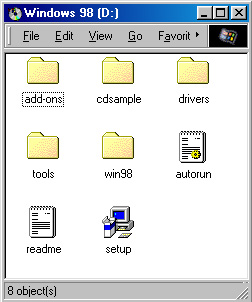
- The figure to the right shows the contents of the \tools\reskit\powertoy subdirectory. (Note: When you display a directory, or folder, you have several options for the setup of the display. The figure to the right shows Details; other options are Large icons, Small icons, and List. To change the format of your display, select the desired option from the View menu option at the top of the window. Details, as the name suggests, provides the most information about the listed files.)
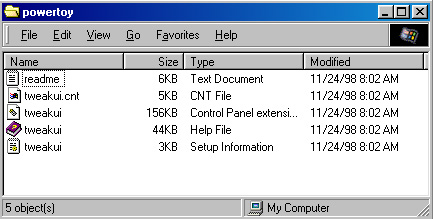
- Installation of TweakUI will add a TweakUI icon to your Control Panel window (shown in the bottom right corner of the figure to the right). To access TweakUI, open Control Panel (double-click on My Computer on your main desktop, then double-click on Control Panel) and double-click on the TweakUI icon.
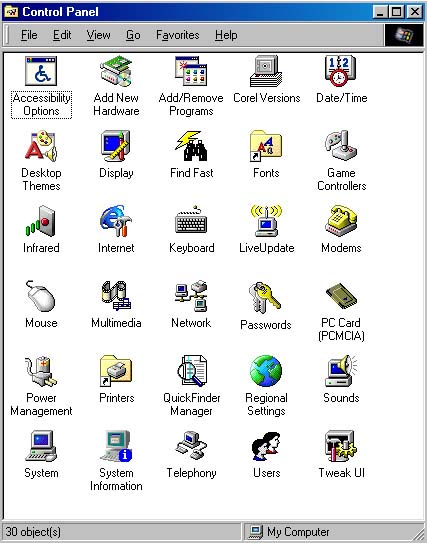
- The figure to the right shows the Paranoia tab window. This window contains (among other items) two checkboxes that you can use to enable or disable the automatic playing of CDs (Play audio CDs automatically and Play data CDs automatically).
The Paranoia window lists several options which might be particularly beneficial to paranoid users. The frame labelled “Covering Your Tracks” lets you turn on features which will automatically delete or clear files during the boot process. Note, however, that covering your tracks can slow down the boot process, so you might want to give careful consideration as to whether these features should be enabled or disabled.
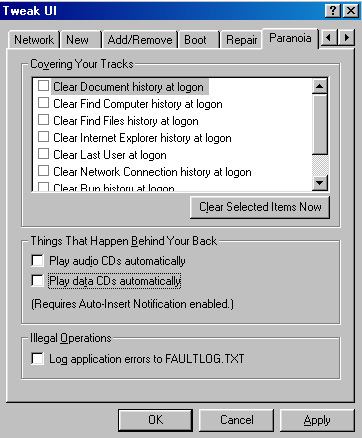
Please let us know if this tip has been helpful. Email to rpearson@cobilan.msstate.edu.
Date posted: 11/15/99
� Original page link from wayback machine https://web.archive.org/web/20240527002828/http://misweb.cbi.msstate.edu/~rpearson/tips/tweakui.html
TweakUI to tweak the user interface
By Alan Zisman © 1999, 2002
Microsoft, who in their infinite wisdom and mercy giveth and taketh away has both given and taken away a powerful, free tool for helping to overcome a host of Windows 95/98/NT/2000/ME annoyances–TweakUI.
TweakUI is a Control Panel add-on, that has been developed by Microsoft programmers, and distributed in various ways by Microsoft, while at the same time, never quite being an official part of Windows, or officially supported by MS. There are several different versions–one for Windows 95/NT 4.0 and one for Windows 95/98/NT if Internet Explorer 4.0 or later is installed–the difference being the changes resulting from IE4’s Active Desktop, a so-called TweakUI 2000 (aka version 1.33) and a version for Windows XP. The XP version is totally different, and isn’t included in this discussion.
The original, Win95 version can be downloaded from Microsoft at: http://www.microsoft.com/windows95/downloads/contents/WUToys/W95PwrToysSet/Default.asp. You’ll find TweakUI-95 along with a number of other possibly useful little utilities. Despite its name TweakUI-95 works fine with Windows 98, 98SE, ME, NT 4, etc.
The Win98 version was included on the Windows 98 CD, in the D:\Tools\Reskit\Powertoy folder, but was removed from the Win98SE (second edition) package. The Windows 98 version can be used with Windows 95 or NT 4.0 if Internet Explorer 4.0 or later have been installed, and works fine with Win98SE, ME, and Windows 2000. It has been replaced, however, by TweakUI 1.33 (aka TweakUI 2000) which can be downloaded from: http://www.download.com/Tweak-UI/3000-2341_4-2830963.html
(Both the original Win 95 and ver 1.33 versions can be downloaded from my website:http://www.zisman.ca )
The very different version for Windows XP can be found, along with other XP Powertoys at: http://www.microsoft.com/windowsxp/pro/downloads/powertoys.asp
Installing Tweak UI
No matter how you got a copy, it installs the same way–locate the TweakUI.inf file (somewhat difficult to do with Windows’ default of hiding file extensions, since there are several Tweakui.* files–here are the files with extensions turned on:

As you can see, the tweakui.inf file looks like a Notepad document with a little gear on it… important if you have file extension-viewing turned off (the Windows default)– in that case, you see four different icons all with the name ‘Tweakui’. Right-click on the inf’s icon, and select INSTALL from the popup menu. You may be asked for the location once or twice–browse to the correct folder. During the installation, you’ll get a help file on screen–read it, then shut it down. When done, you won’t find an icon for TweakUI in the Start Menu–it installs as a Control Panel icon. (The WinXP version installs into the Start Menu and not the Control Panel– just one of the ways it’s different).

Start it up by double-clicking– you’ll see a dialogue box with multiple tabs–the Win95 and 1.33 versions arrange them in several rows, while the Win98 version has a more awkward arrangement, showing a single row with arrows at the right hand end to move forward or back, to view additional tabs.
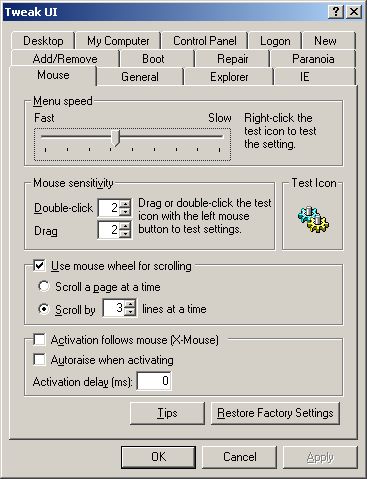
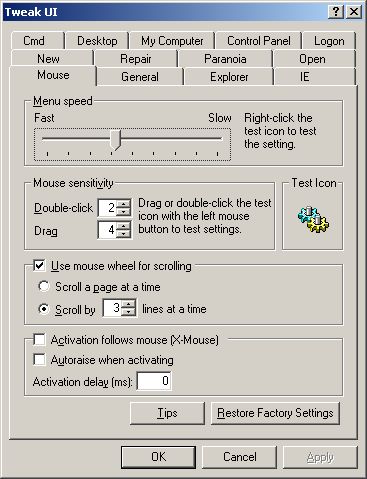
Here are pictures of TweakUI 1.33 installed on Windows 98SE and Windows 2000 systems- note that there are some differences in the contents of the various tabs.
Mouse tab

You can speed up how fast menus drop down (or open sideways, as in the Start Menu), and test the various speeds by right-clicking on the Gear picture. You can adjust mouse sensitivity for double-clicking and dragging (and again, test your changes). If you have a wheel mouse, you can set how much is scrolled at a time. The X-Mouse setting is more typical of Unix systems–an items is selected by simply resting your mouse over it, rather than by clicking it. Note that you can experiment freely, since you can restore the factory settings with a click of a button.
General tab

The W98 version has lots of settings in the Effects section, while the Win95 version just has the top 3–though I tend to leave them all alone. Similarly, I pretty much ignore the options to reset Special Folders–the default location for Program Files, and more.
If you’ve mysteriously got the Windows version and build number appearing the lower right-hand corner of the screen, you can turn it off here–it’s the last item, hidden in the Effects list.
Explorer tab

More useful–this one, for example, in the Settings section, lets you turn off the annoying ‘Prefix ‘Shortcut to’ on new shortcuts’. Hallelujah! You may be tempted to use the top section to turn off the arrow on shortcuts–resist tempation. It’s actually important to be able to easily tell the difference between an icon that’s a shortcut, and one that’s an actual program or document file. Deleting a shortcut is no big deal–the actual file remains. Deleting the real file by mistake, however, could have serious consequences. Leave the shortcut arrow alone!
IE or IE4 tab (Win98 and 1.33 versions only)
This is called the IE tab in version 1.33.
Again, a scrolling list of options, available even if you’re using a version of IE later than 4: You can use it to easily enable or disable Active Desktop. Turn off adding documents to the Start Menu’s Documents list. Clear the various history lists (Document, Run, etc) automatically on exit. You can also turn off showing Documents or Favorites at all in the Start Menu. (I leave Documents, but turn off the Favorites list). In version 1.33 you also get an item allowing you to turn off undefined ‘Shell Enhancements’– this removes the Win98-style interface additions– primarily the Toolbars (little-icons beside the Start button), making your interface more like the original Windows 95 one.
Desktop tab

Finally–a way to turn off some of those sticky desktop icons, that won’t easily remove, even though you never use them–for instance, the Microsoft Exchange InBox in Win95– or the Internet Explorer icon. Or, if you don’t want it visible, the Recycle Bin. If, before unchecking an icon, you Create it as File, you can store it in a different folder, but you can always get the icons back, if needed, simply by rechecking it, here.
Note that you can’t turn off display of My Computer. And no, I don’t know why some icons appear twice… but I’ve sometimes found that with two Internet Explorer icons, (for example), one will work to start up the program while the other one does nothing if double-clicked!
My Computer tab
A list of possible drive letters, A-Z, even if most of these are not currently available on your computer. Unchecking a letter means that that drive letter no longer appears in My Computer, or in the File/Open and Save dialogue boxes of your applications. Oddly, the unchecked drives still seem to appear in Explorer– turning off drive C:, for example, means that users won’t be able to easily (and perhaps accidentally), save to their local hard drives–but can still save to designated network drives, or floppy drives. I’ve done this on my student machines, where I don’t want students saving to the hard drive. (Even though the icon is hidden, you can make an Explorer window to a hidden drive appear by typing the drive letter in the Start Menu’s RUN dialogue).
Note that if you uncheck any drives, you can no longer edit the Start Menu by right-clicking on the Start Button and choosing Open or Explorer from the popup menu–those items are greyed out. As far as I can tell, this is a bug, not a feature but continues through version 1.33. You can still edit the Start Menu by right-clicking on the Taskbar, and choosing Properties from the popup menu.
Control Panel tab
This lists the various *.CPL control panel files, and lets you unselect ones you’re unlikely to use–they will no longer show up in the Control Panel. For instance, you may not need to see the Game Controllers control panel icon on a notebook with no game port. Or the Regional Settings control panel. Or the ODBC Data Access control panel installed by Microsoft Office, if you’re not accessing these sorts of large corporate databases. Or the Telephony control panel. Turn them off and remove some clutter– you can always easily get them back it you need to!
Network or Logon tab (Win 98 and 1.33 versions only)
A single option–to automatically logon. It notes, however, that any password you list here is not encrypted, and can be viewed in the System Registry, using Regedit. Still, this is especially useful on a single-user computer running NT or Windows 2000, which insist on a user logon (unlike Win 95/98)– as it can logon automatically for you at each bootup. It can also be useful on a Win9x system if it connects to an NT/W2000/XP network to share files or printers.
New tab
When you right click on the Desktop or elsewhere, you may notice NEW as an option in the popup menu– clicking on it gives the useful New Folder option, as well as a bunch of new, blank documents for various programs. Does anyone actually create new documents this way? By default, you may even have the option to create blank documents for programs that you don’t even own. This item lets you remove items from the list. You may want to leave the New Briefcase item in the list–that way, you can delete the Briefcase from the Desktop, and still have a way to get it back in the unlikely eventuality that you want to try it out someday.
Add/Remove tab
This resembles the list in the Control Panel’s Add/Remove Programs item– but unlike that one, it doesn’t remove any programs. What it does, is remove an item from the main Add/Remove list–useful in case a botched up program uninstallation fails to remove the item from the Control Panel list (or you manually deleted a program’s folder, rather than using the Control Panel item to remove it the right way!) If you have a Windows 3.1 program that included an Uninstall icon, but doesn’t automatically add itself to the Control Panel list (MS Works 3.0, for example), you can click on the New button, to add it to the Control Panel list–first, find the properties of the Uninstall icon, and copy down the command line–then you can enter the exact same thing in the Command field here–so that choosing it from the Control Panel will run the correct program.
note: If you’ve installed the current 1.33 version on a Windows 2000 system, this tab does not appear- though it does appear with that version of TweakUI installed onto a Win98 system. Curious! However, if you try to remove an application in Win 2000’s Add-Remove control panel, and the uninstall doesn’t work, Win2000 offers to remove the application from the Add-Remove list, so this TweakUI item is less needed in this case.
Boot tab (Win95/98 only)
This lets you turn on or off a variety of settings at system startup–whether the F8 function key, for example, can be used to call up the boor menu, whether Win9x starts up automatically, whether the Microsoft cloud screen appears at startup, and whether you can boot to your former operating system (only on machines that were upgraded from DOS/Win 3.1). You can also set it to always show the boot menu, for a set number of seconds–useful in some trouble-shooting situations.
Repair tab
Very useful! Ever had desktop or System Tray icons get munched somehow, and show the wrong icon? Pick the Rebuild Icons item here, and click the Repair Now! Button, and you may be able to fix them. Also useful, from the dropdown list is to repair the Font Folder, if you’re having trouble displaying or accessing fonts. The other items are less commonly needed.
Paranoia tab
Aptly named! This lets you automatically cover your tracks by emptying the lists of Recent Documents, Run, Last User, and more whenever the system restarts. Nice to set on computers used by multiple users– so Johnny doesn’t get to see what documents Mary was working on. As well, for no good reason, you can set audio and data CDs to play automatically–or not. (Note–for this to work, you need to have Auto-Insert Notification turned on– If this isn’t working for you, go to the System control panel, and go to the Device Manager tab. Find your CD-ROM drive in the list of devices, select it, and click the Properties button. Go to the Settings tab and make sure [x] Auto-Insert Notification is checked.
More…
There are a number of tabs that I haven’t covered– hopefully the options are either obvious, trivial, or so complex that most users can safely ignore them! Feel free to check them out, however, and if you have any questions, email me.
And that’s it– a lot of items that you can happily ignore, but several that can make your life much easier (turning off easy access to Drive C: for example, in a networked classroom), and some that simply clear up some common annoyances, such as the undeletable desktop icons, or the stupid ‘Shortcut to–’ prefix on shortcuts.
Alan Zisman is a Vancouver educator, writer, and computer specialist. He can be reached at E-mail Alan
� Original page link https://www.zisman.ca/tweakui/
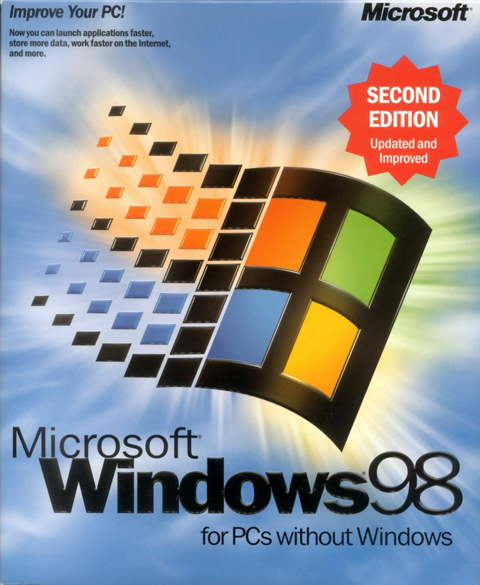
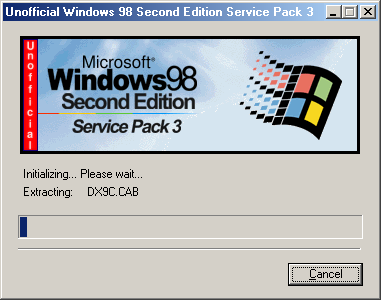
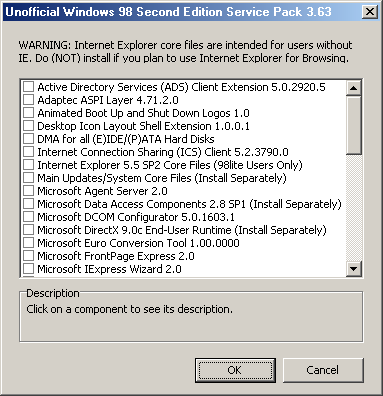
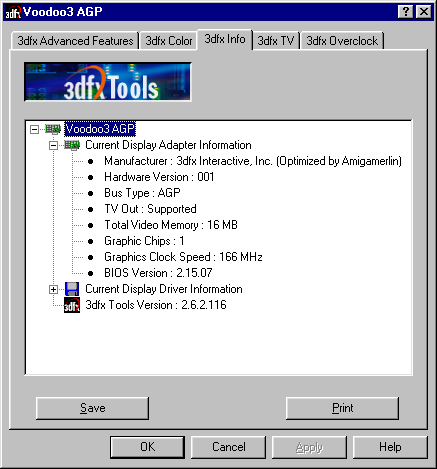
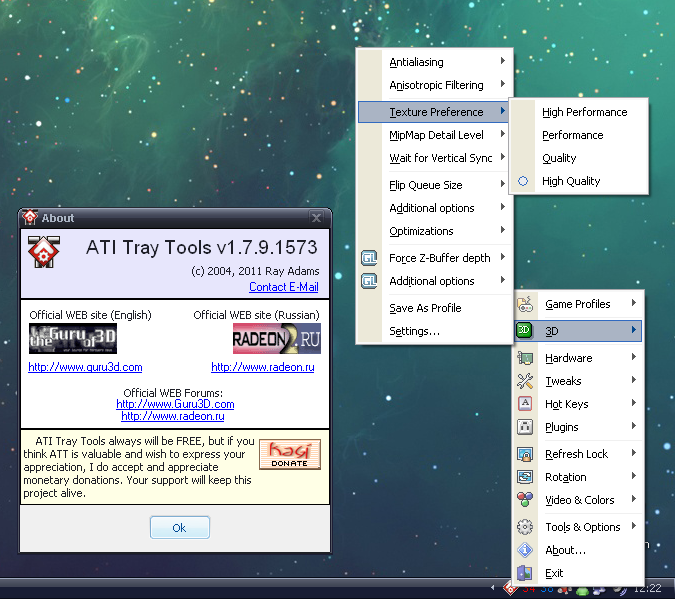
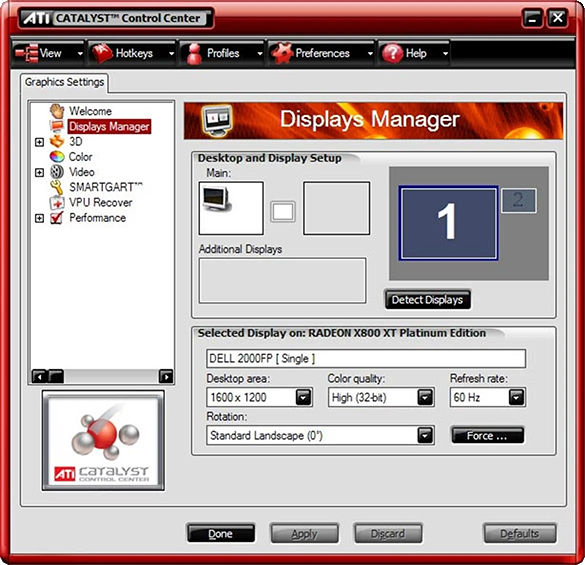
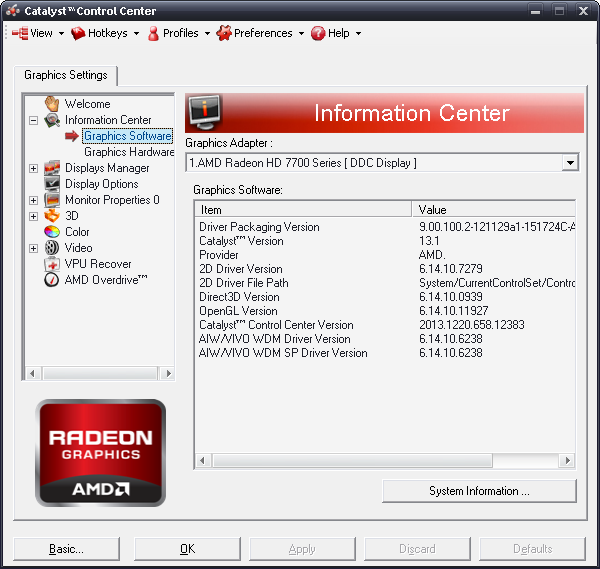
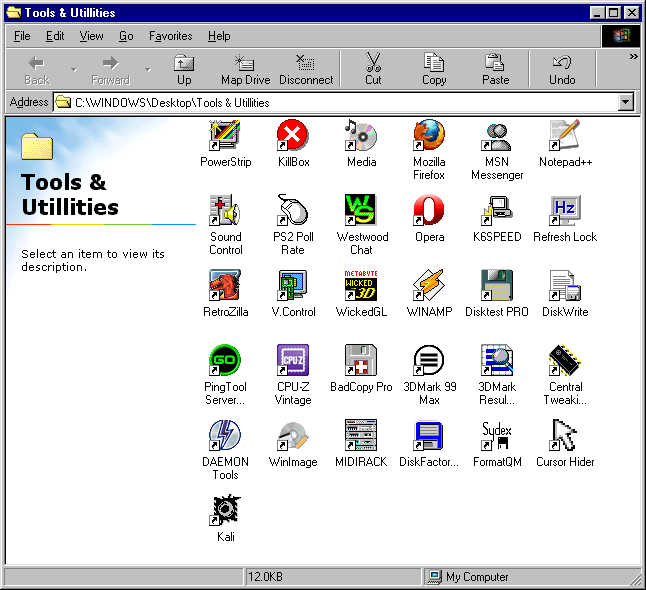
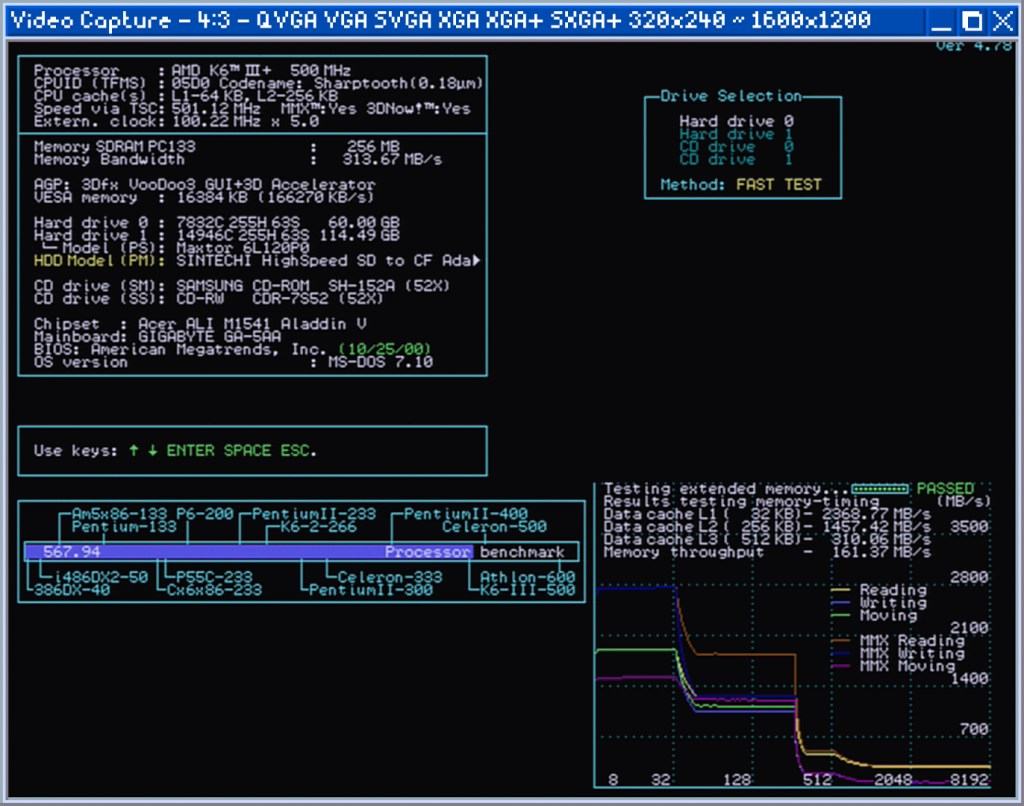
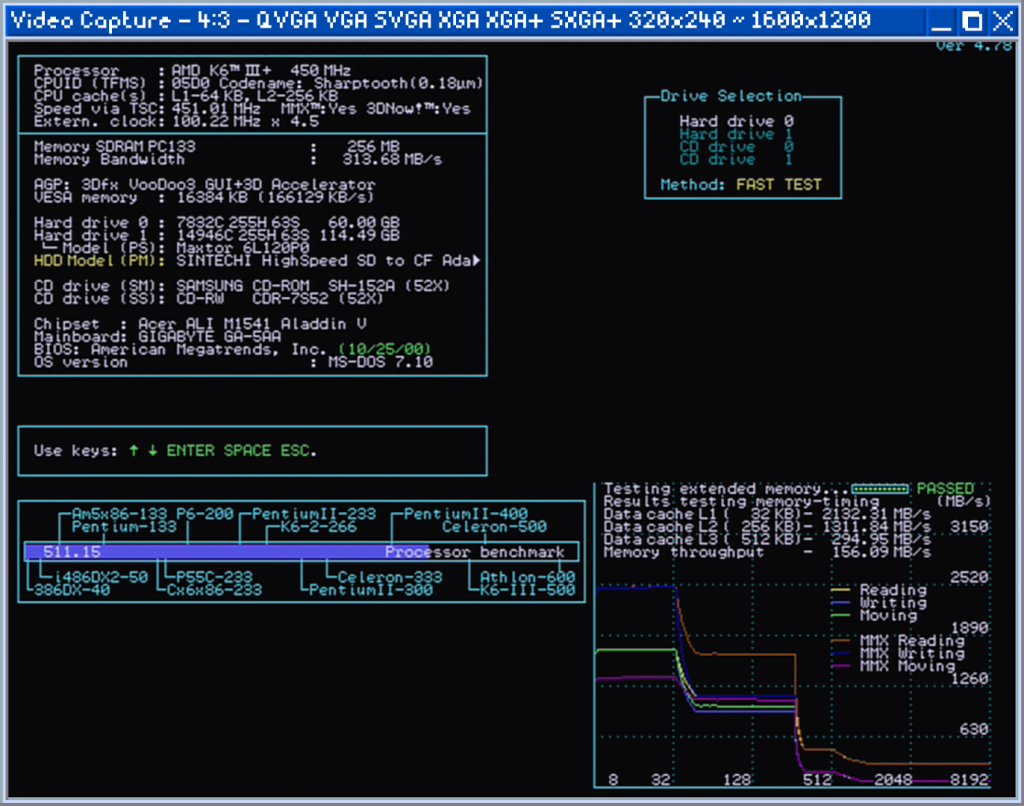
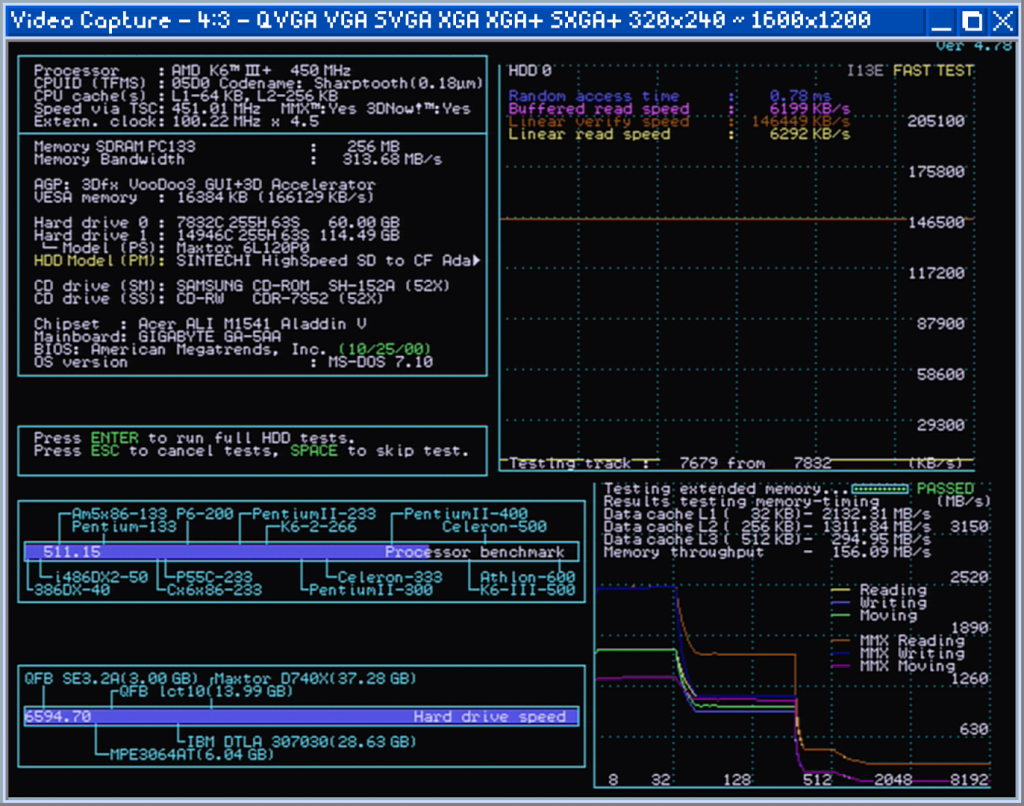
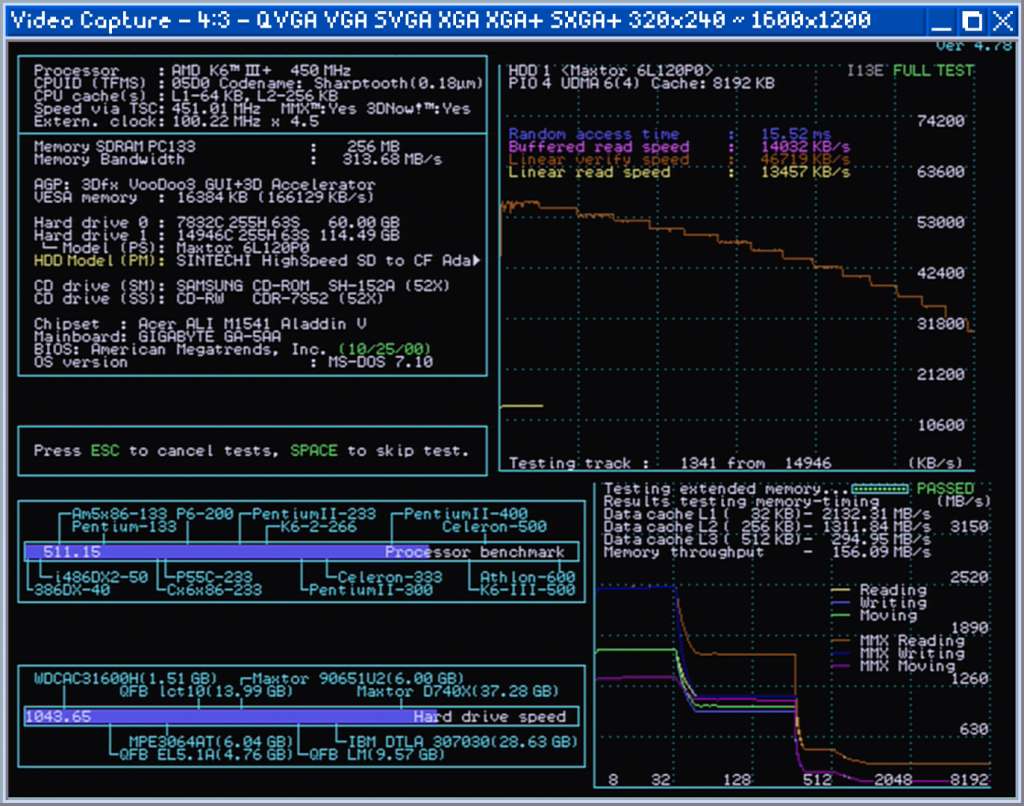
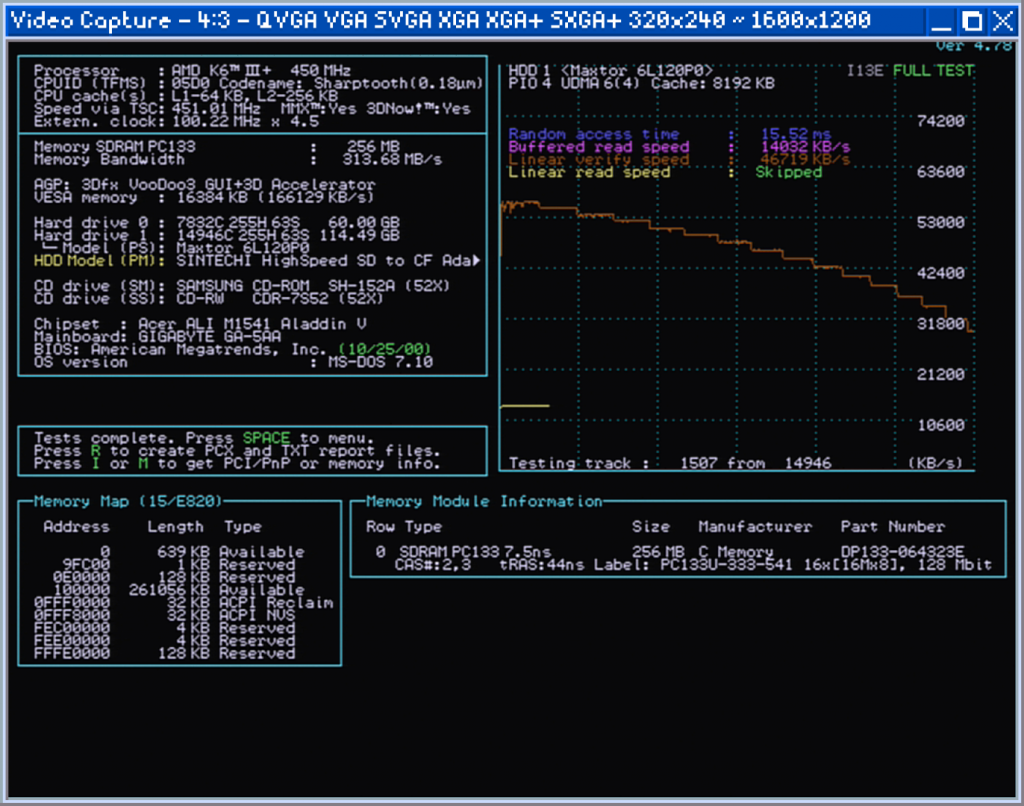
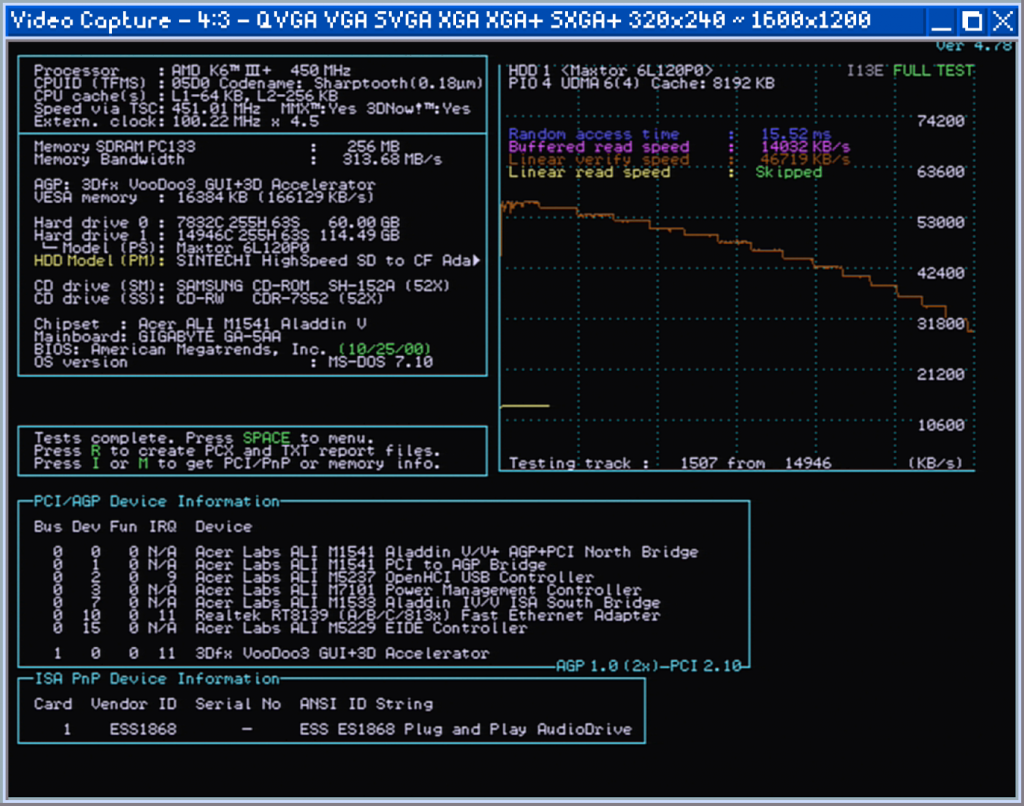




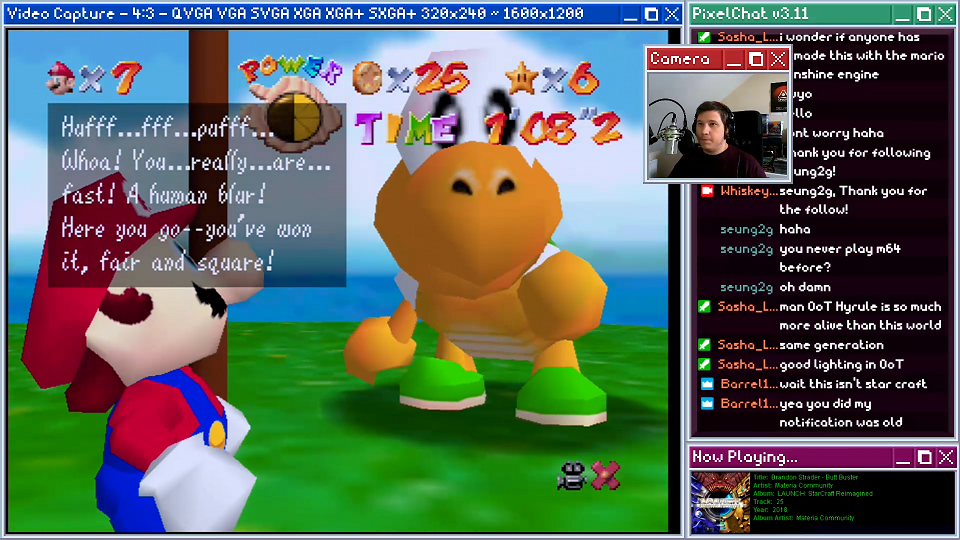
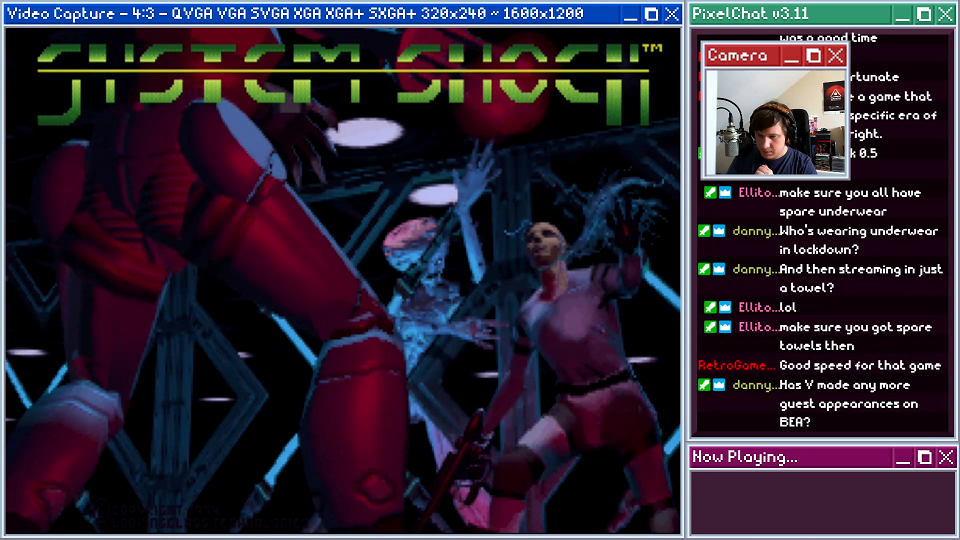
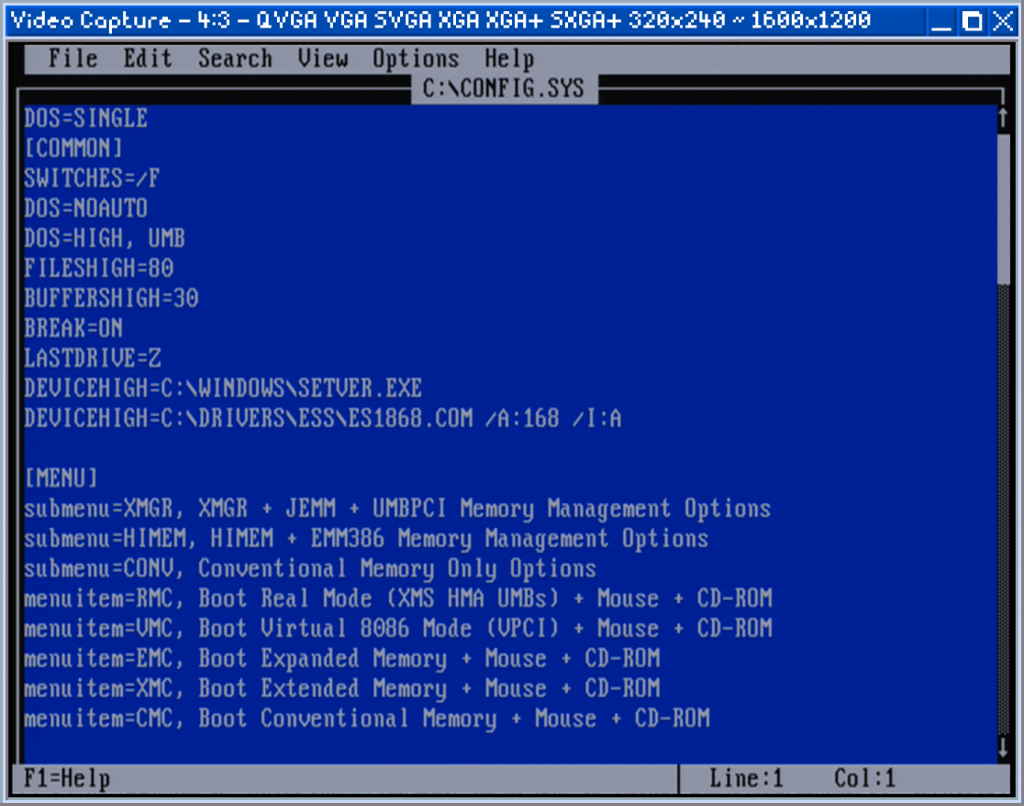
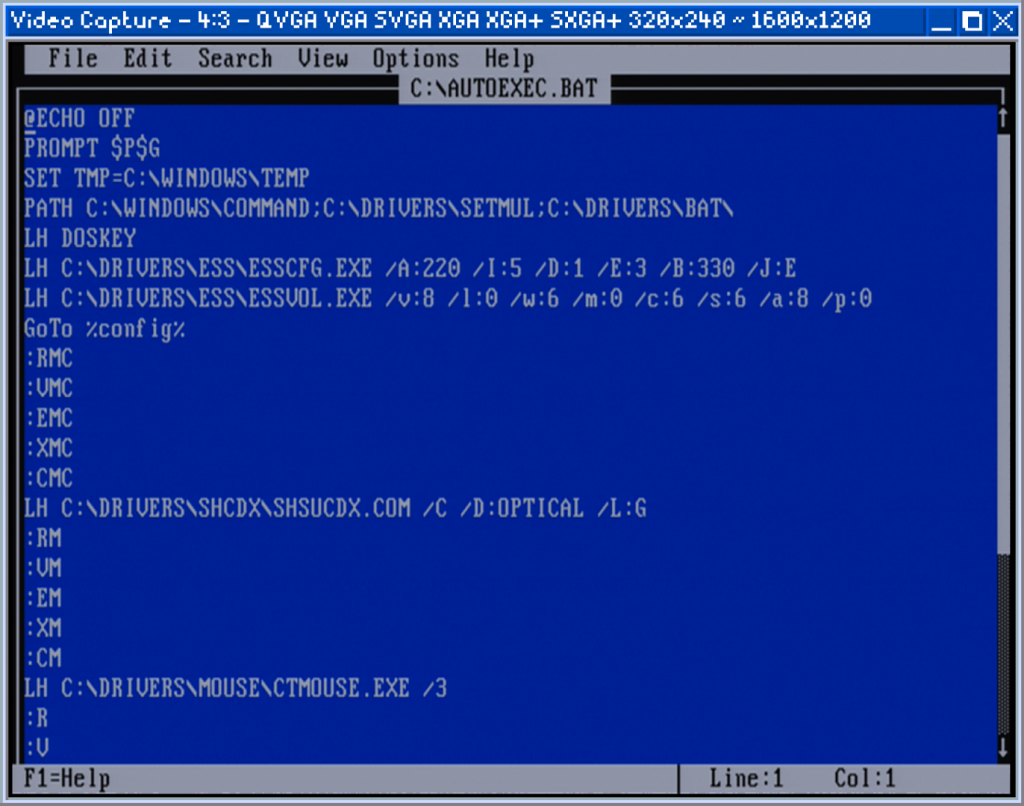
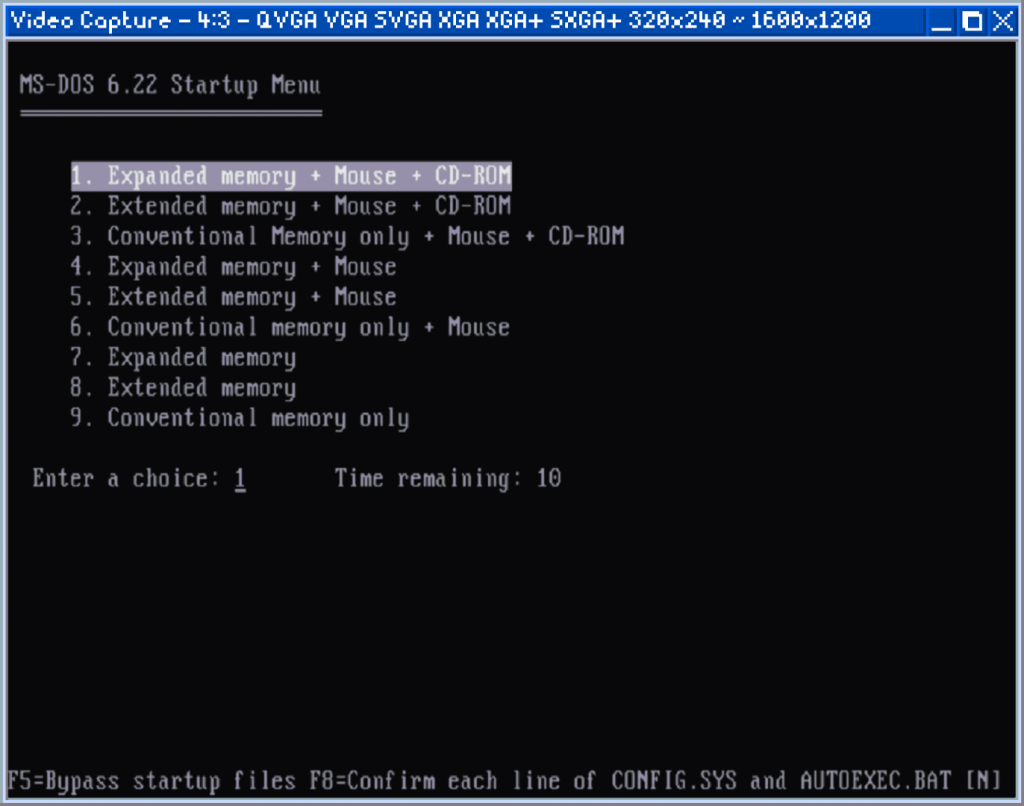
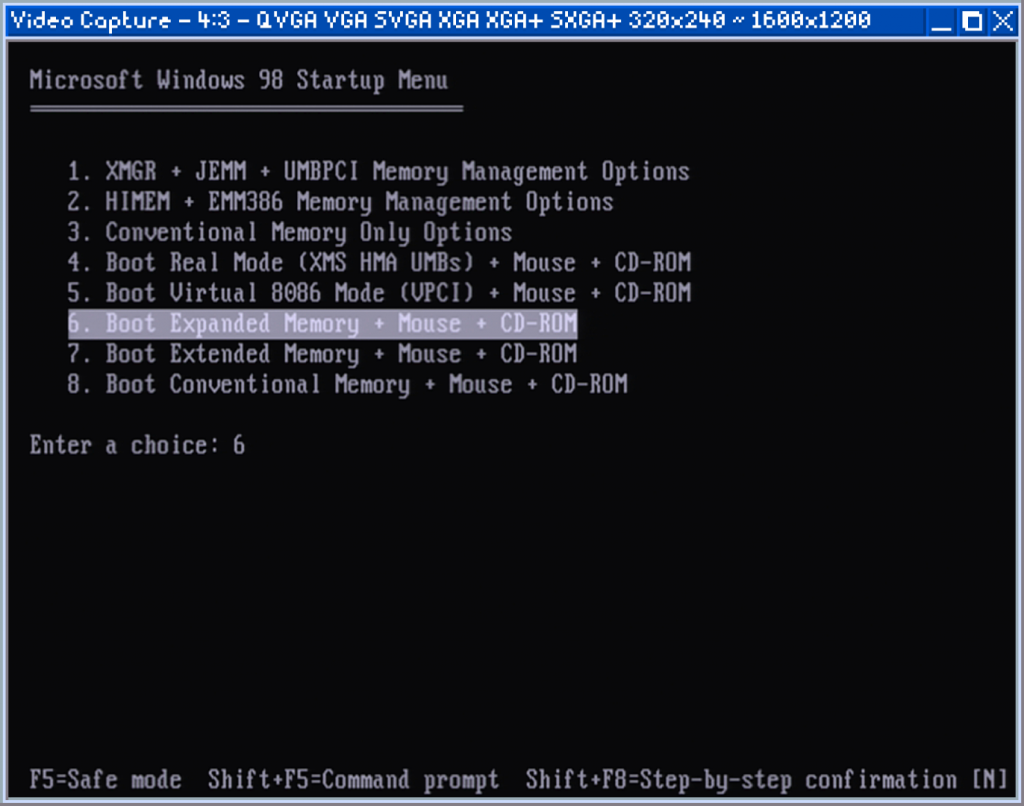
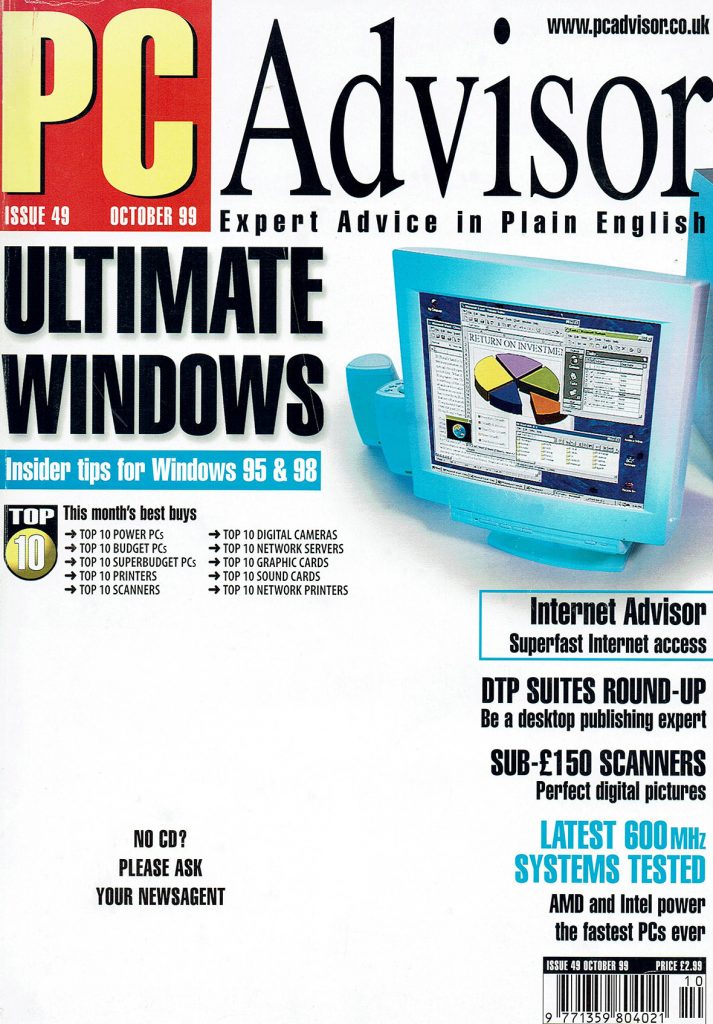
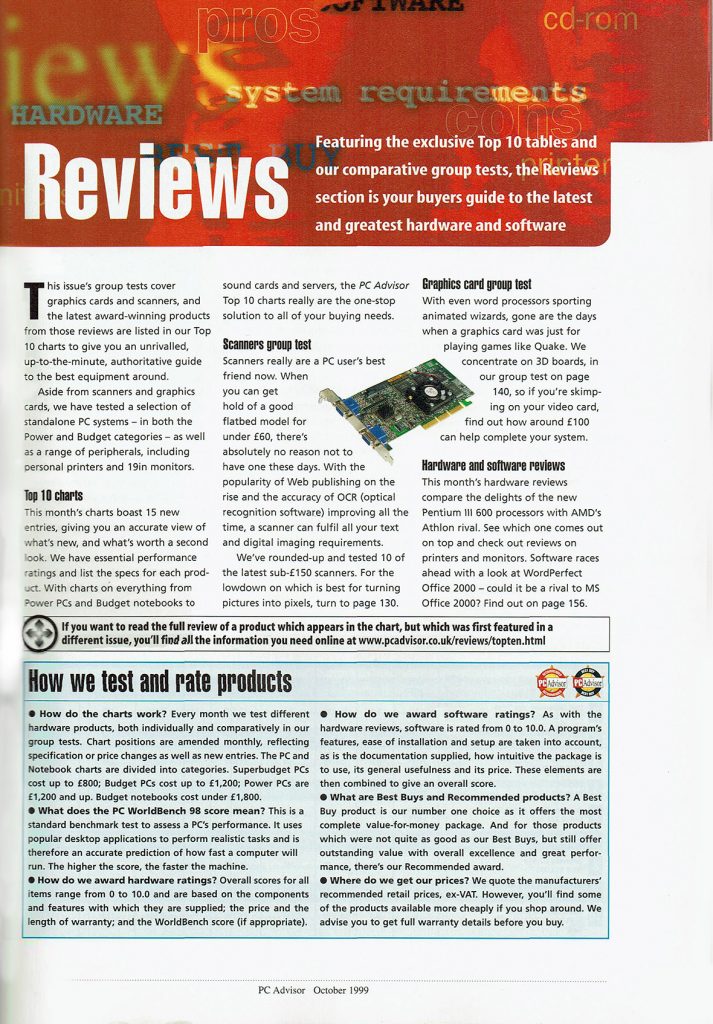
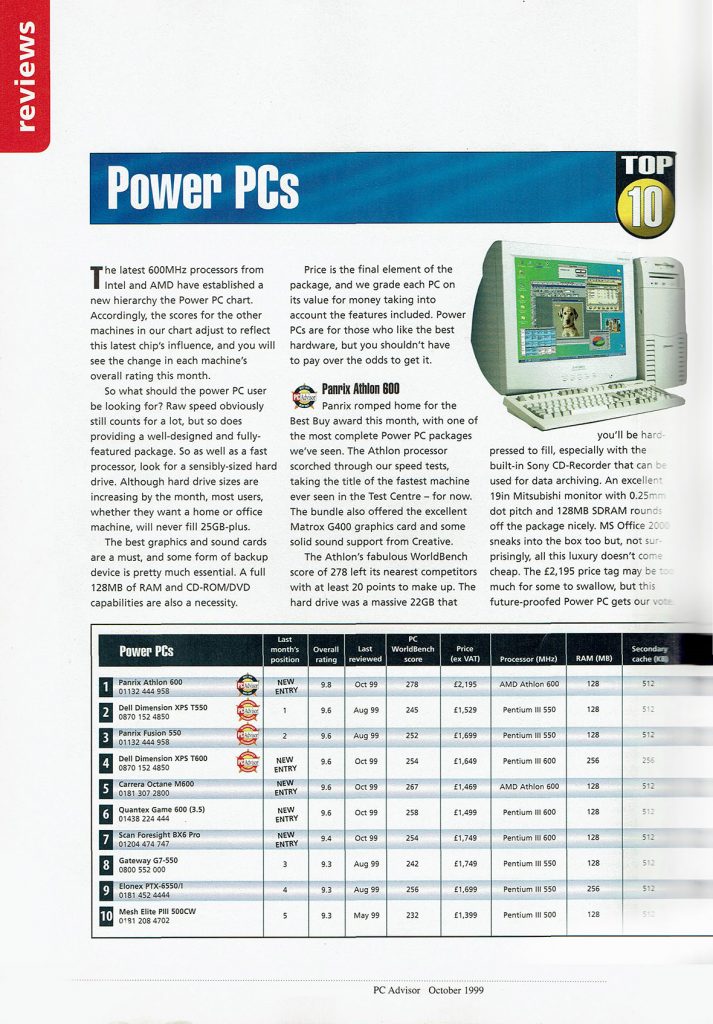
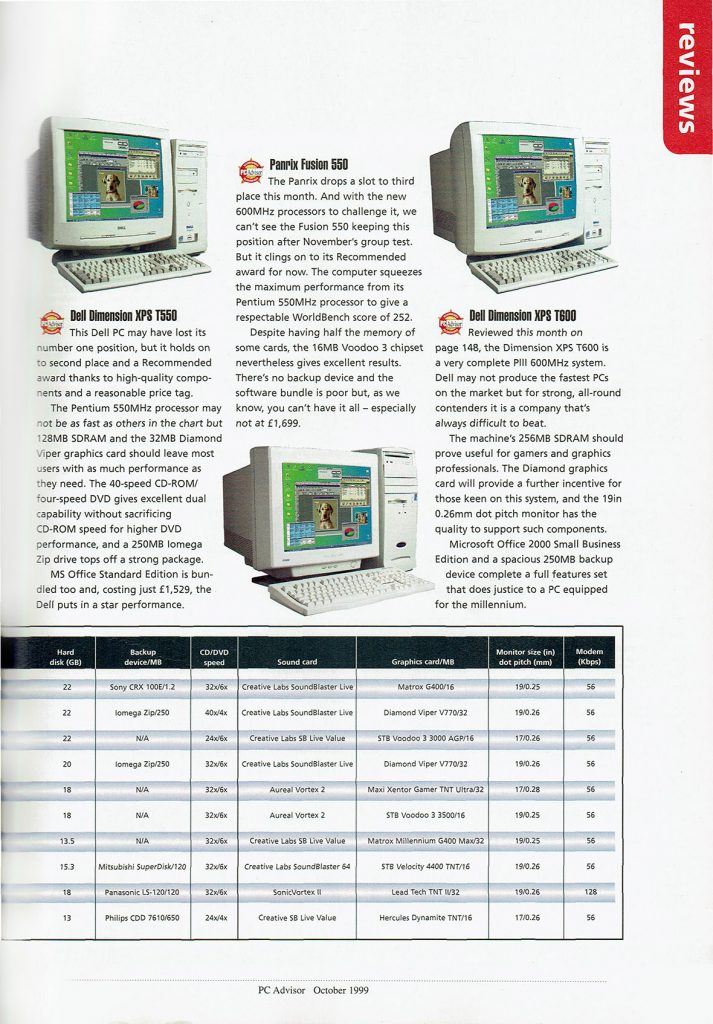
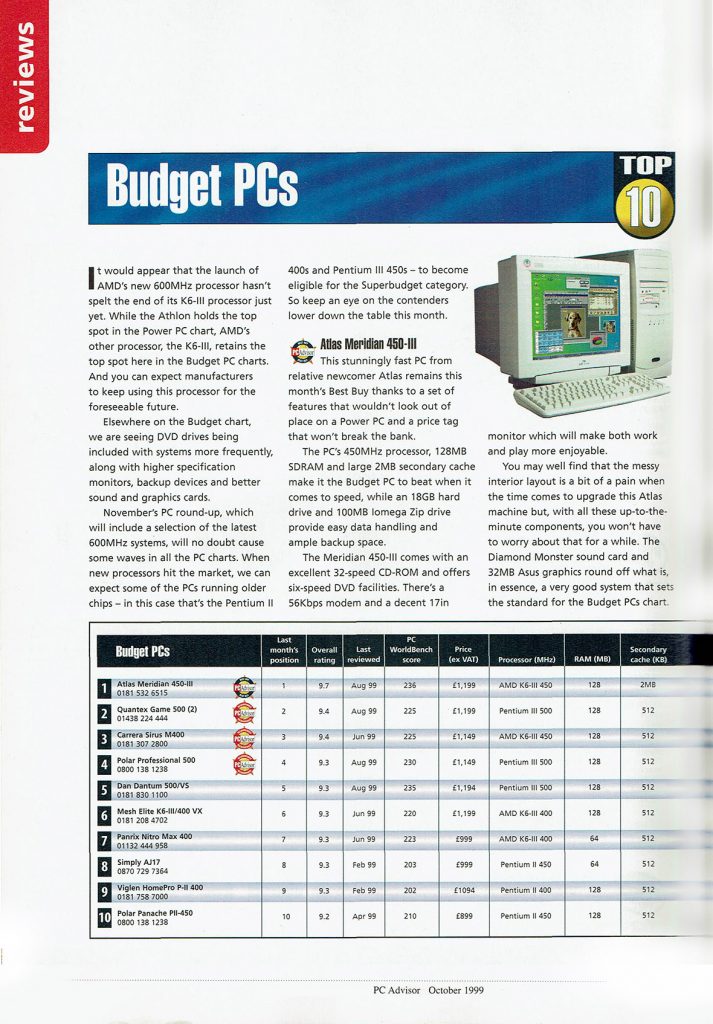
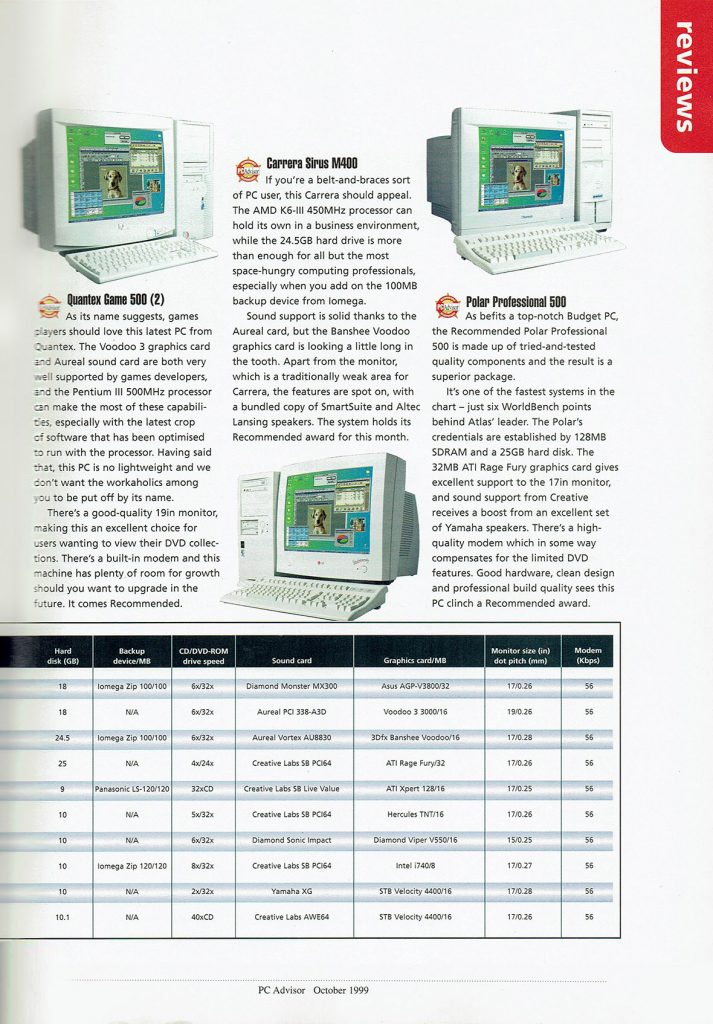
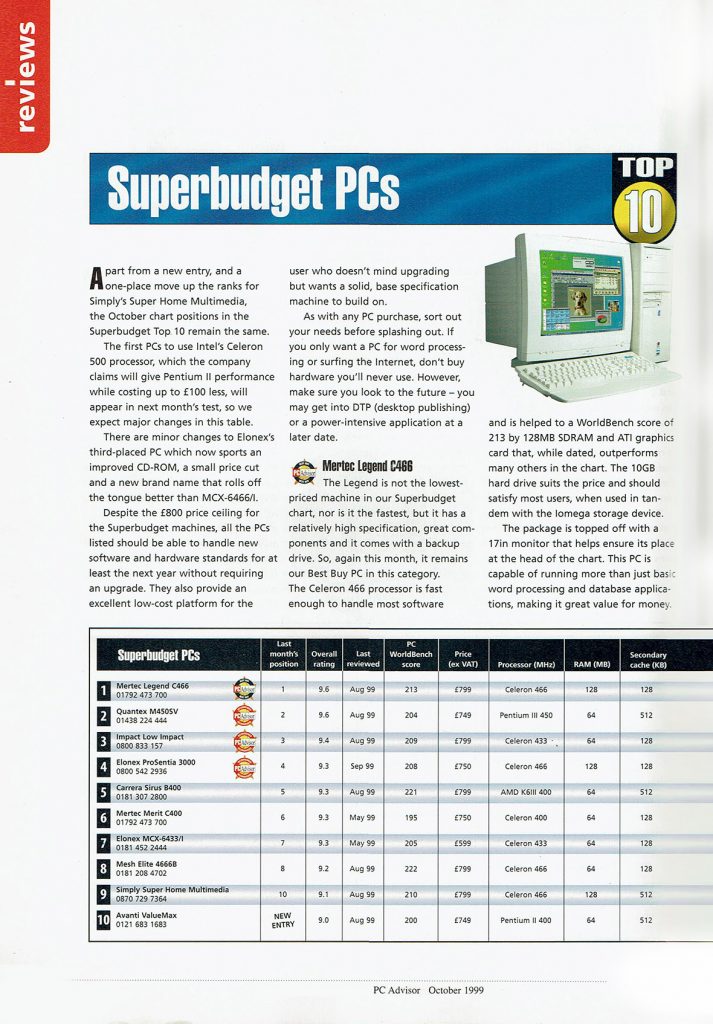
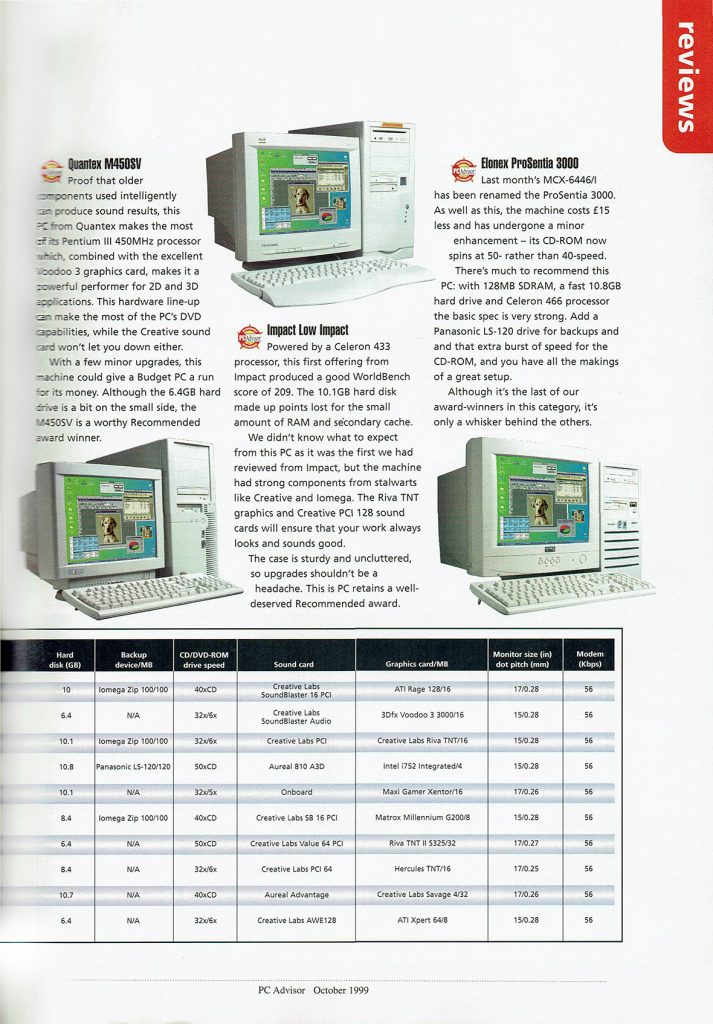
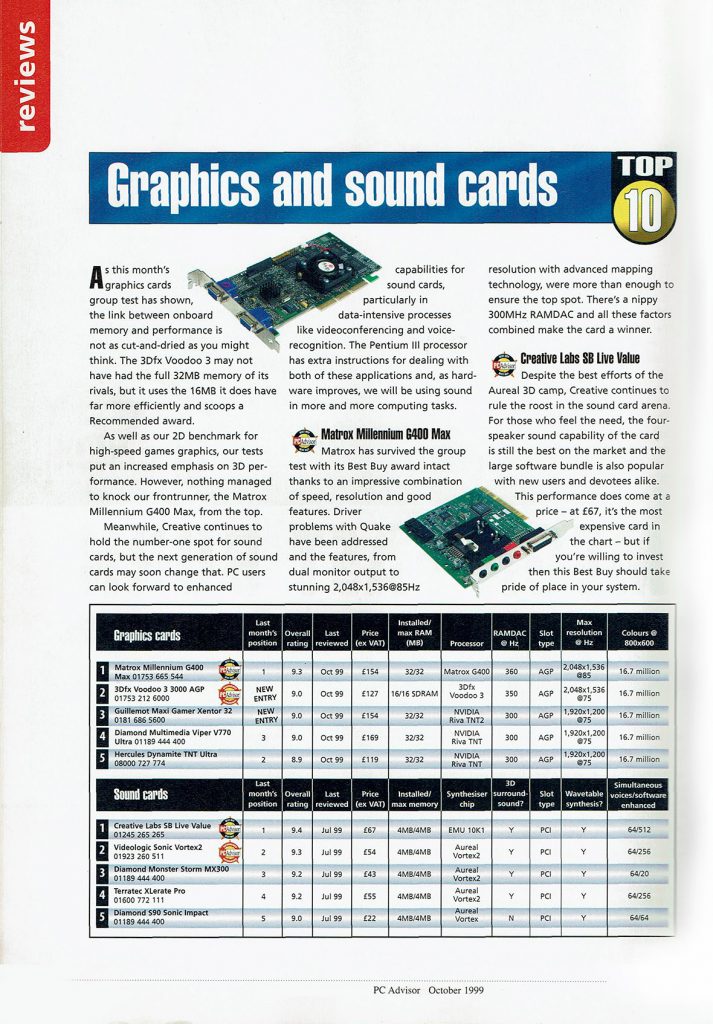
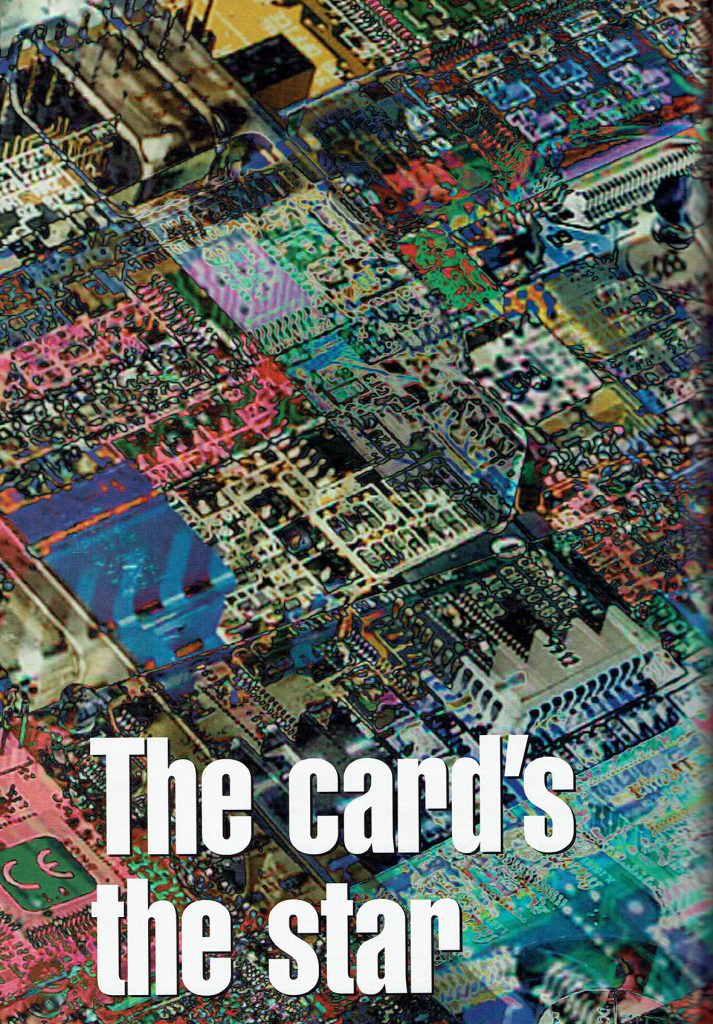

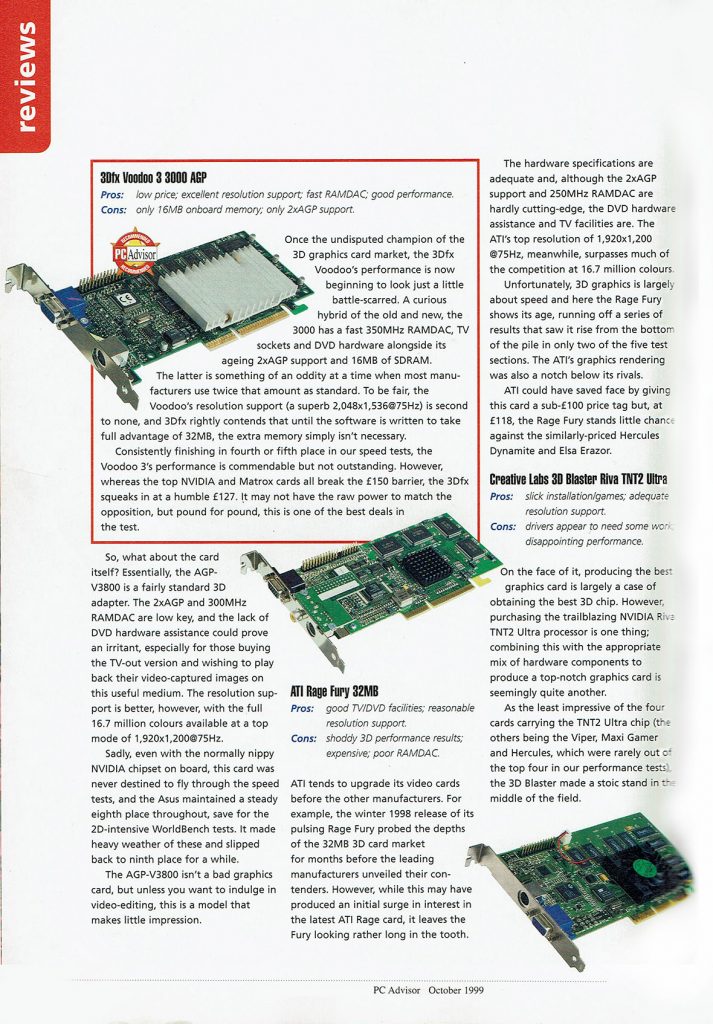
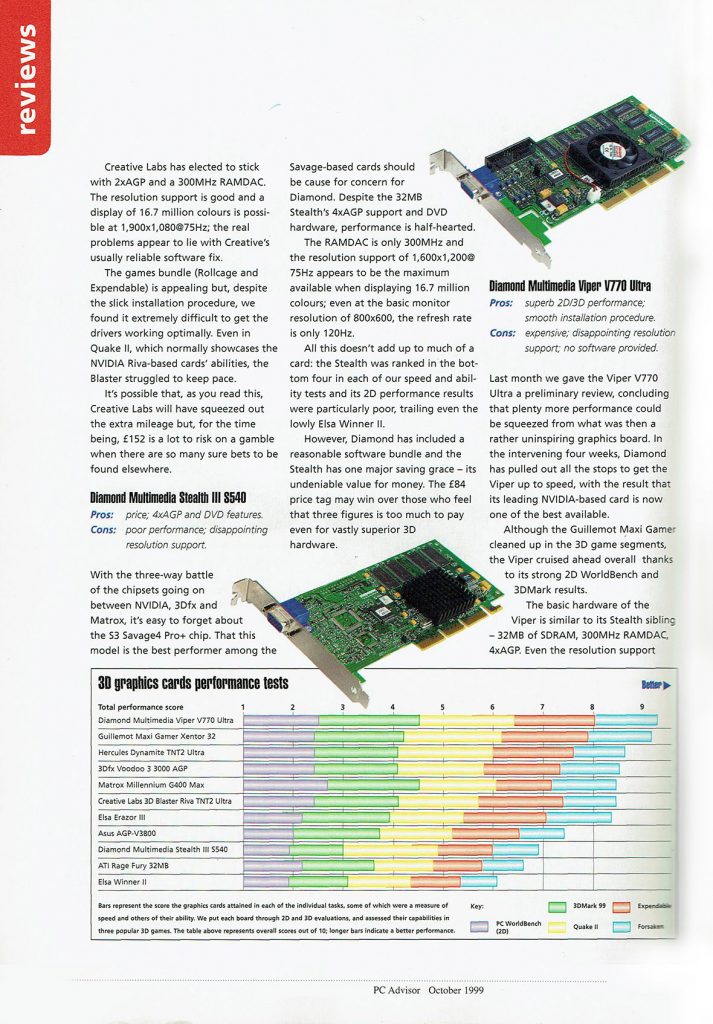
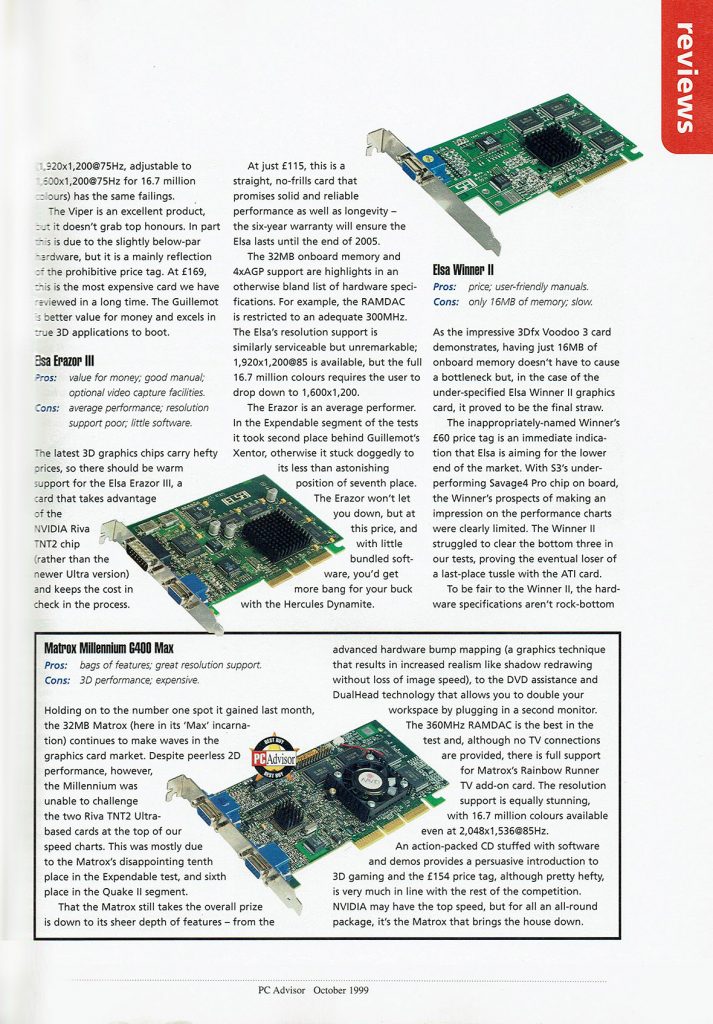
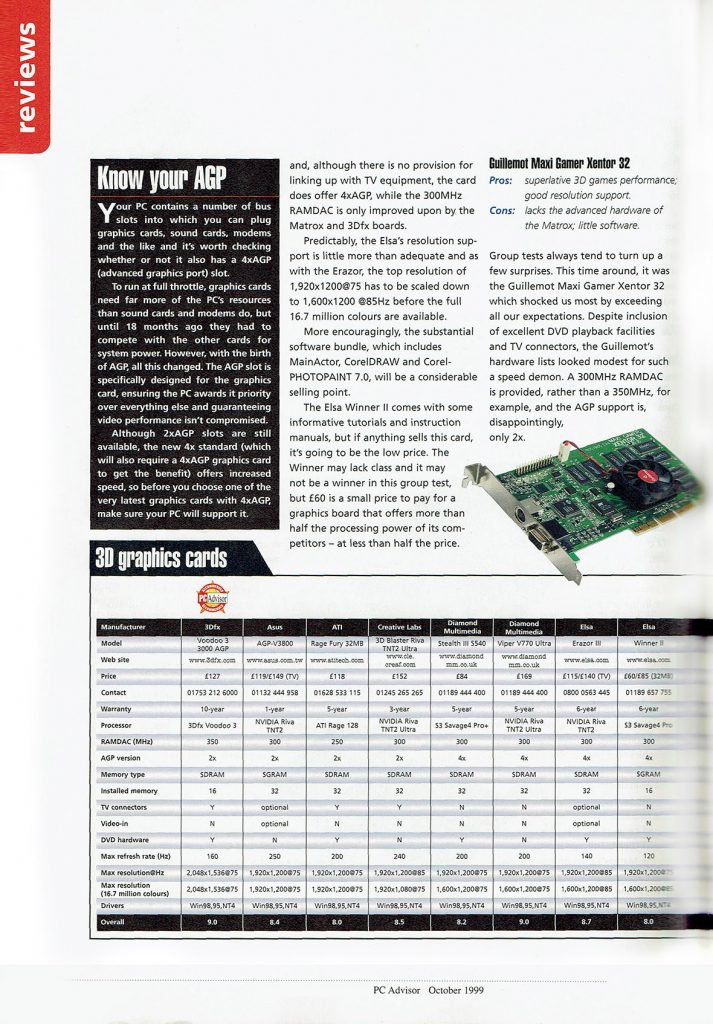
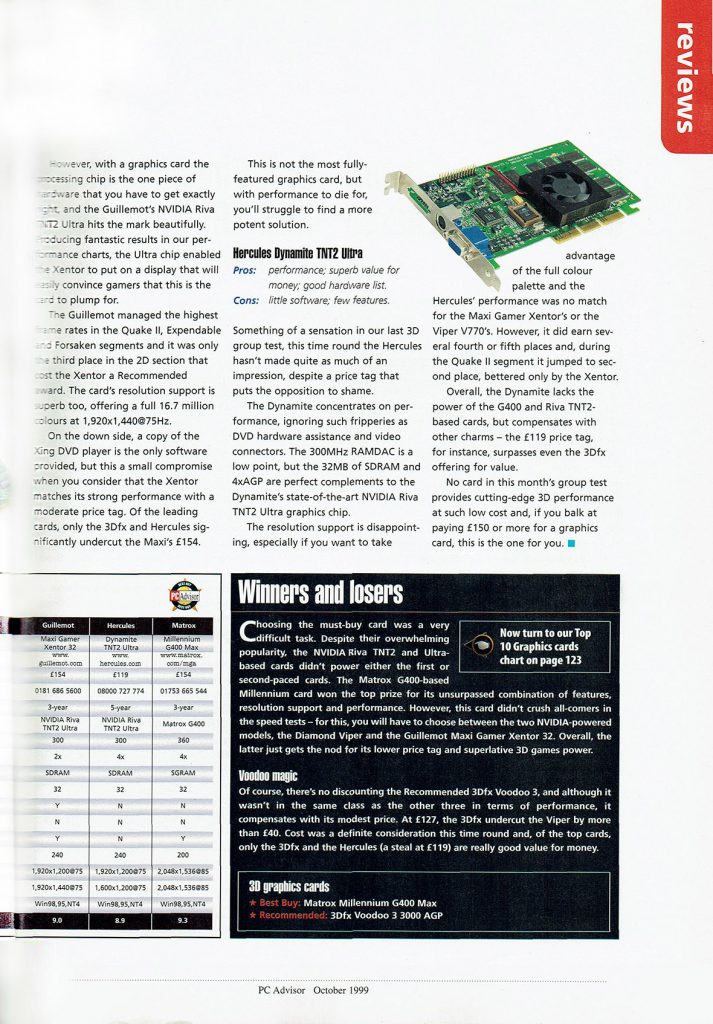
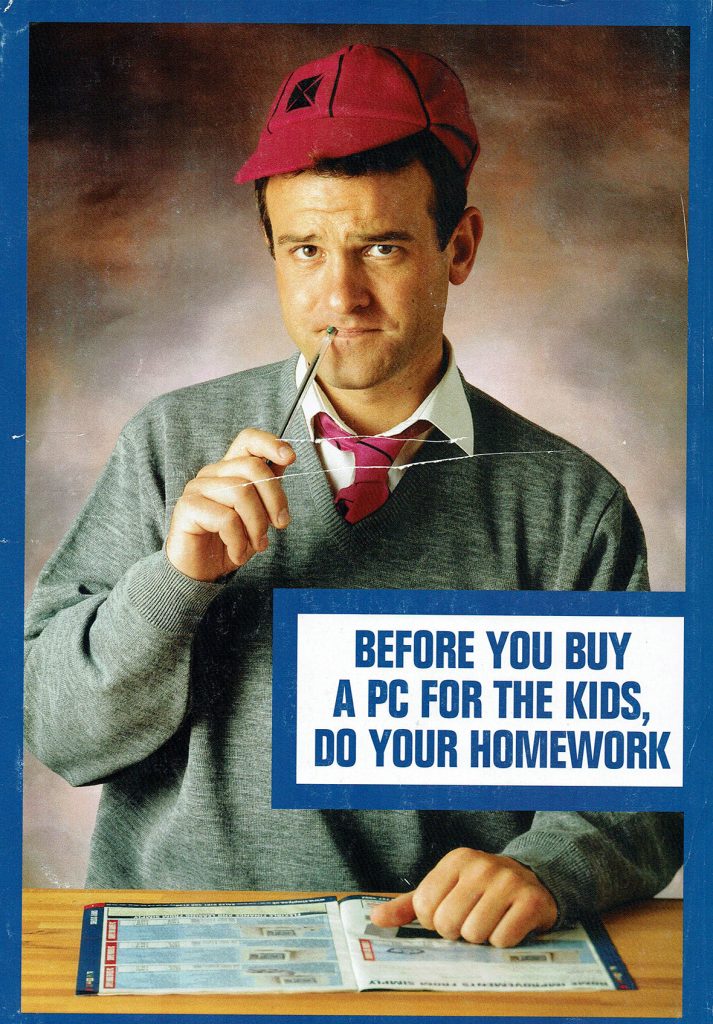
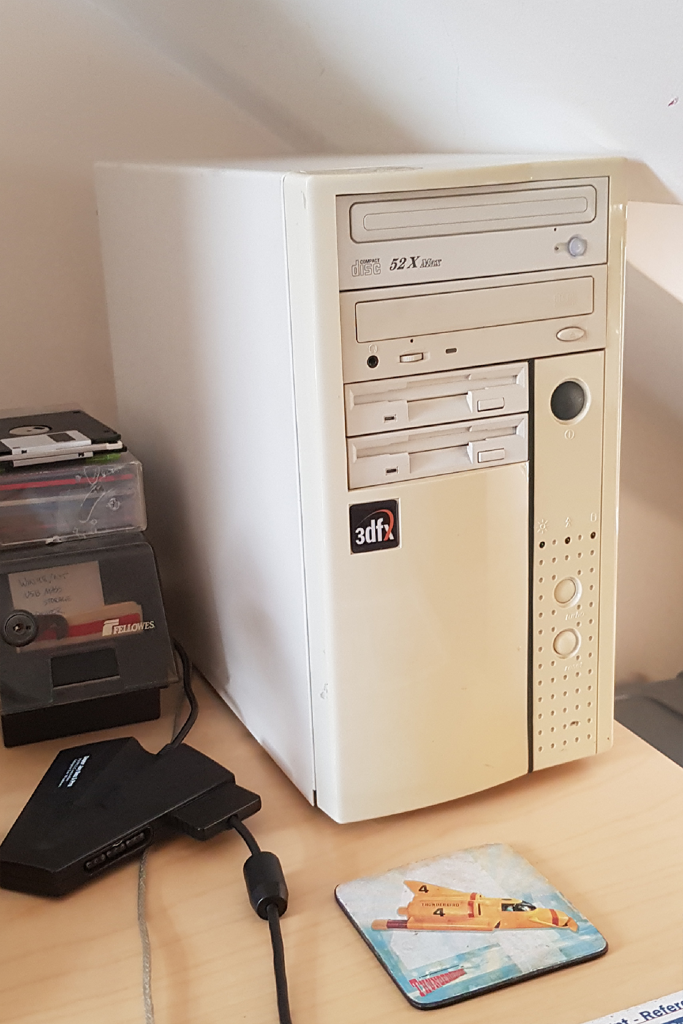
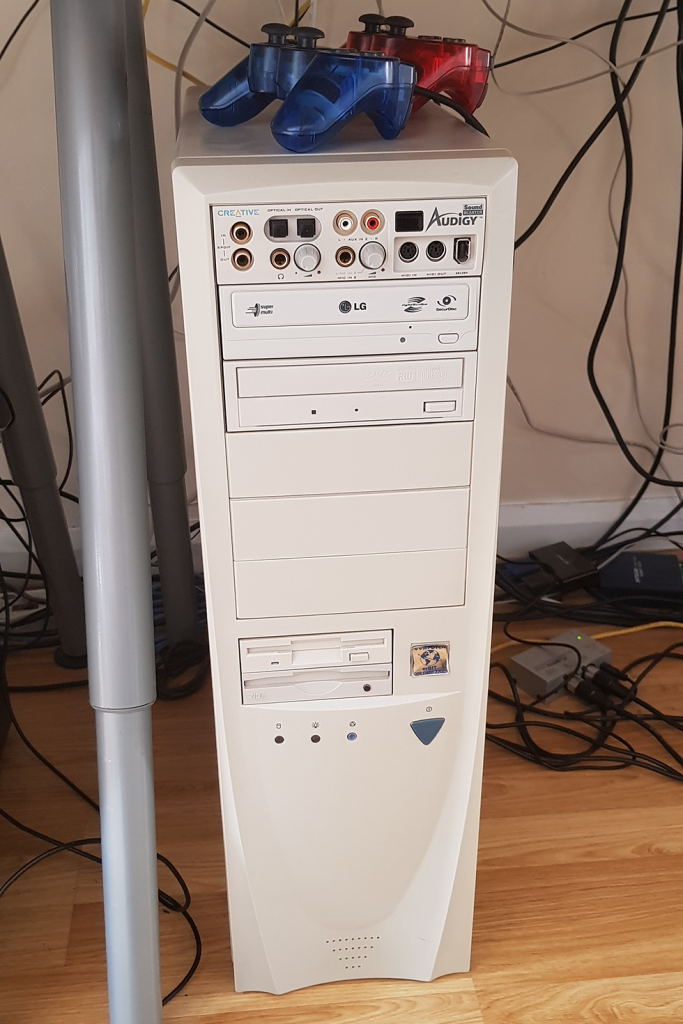
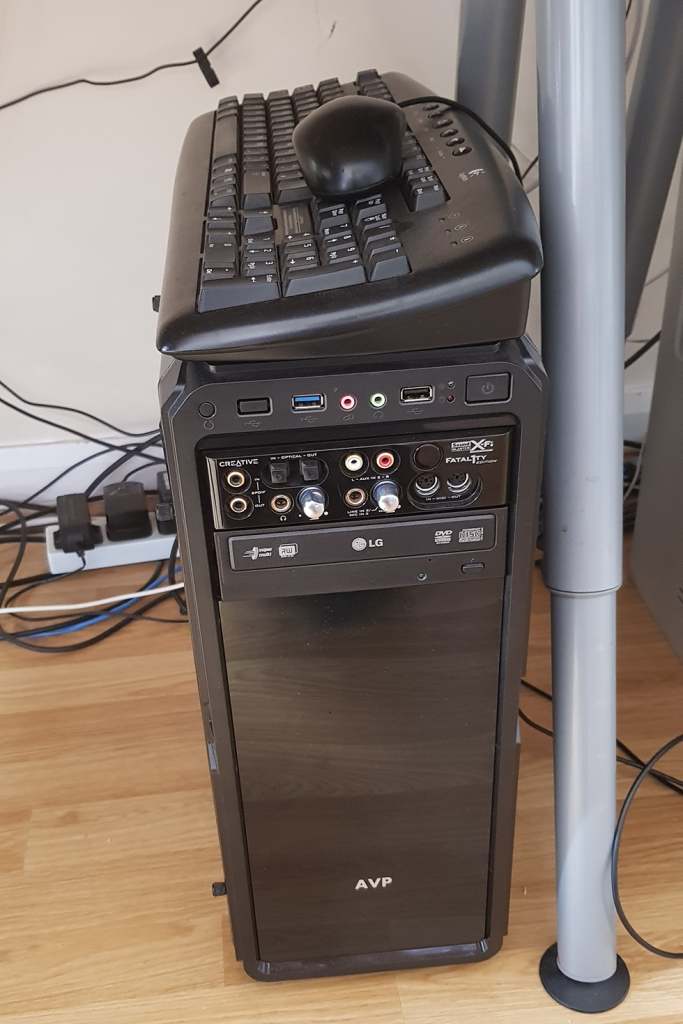
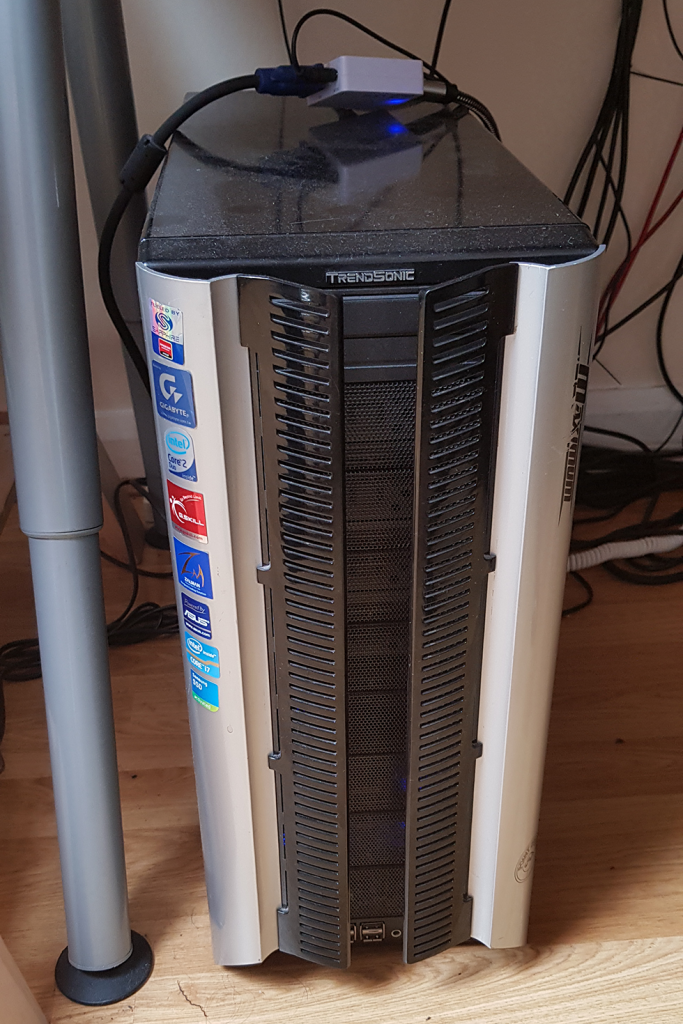
You must be logged in to post a comment.